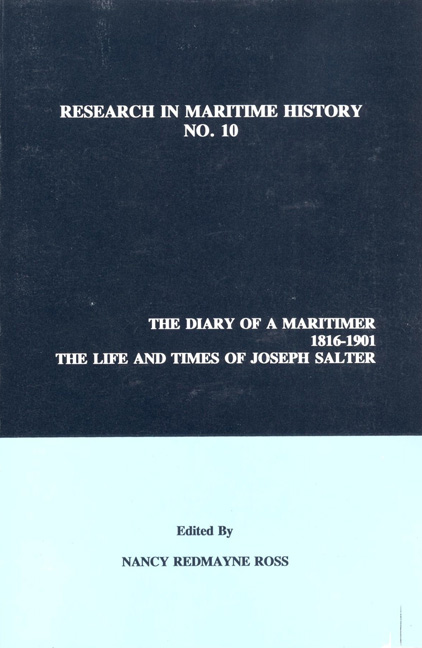Book contents
- Frontmatter
- Contents
- Foreword
- Introduction
- List of Illustrations
- Chapter 1
- Chapter 2
- Chapter 3
- Chapter 4
- Chapter 5
- Chapter 6
- Chapter 7
- Chapter 8
- Chapter 9
- Chapter 10
- Chapter 11
- Chapter 12
- Chapter 13
- Chapter 14
- Chapter 15
- Chapter 16
- Appendix 1 Vessels Owned by G. & J. Salter, 1852-1857
- Appendix 2 Patent Application, 1867
- Appendix 3 Genealogy
- Appendix 4 A Brief History of the Shipyard of G. & J. Salter
Appendix 2 - Patent Application, 1867
- Frontmatter
- Contents
- Foreword
- Introduction
- List of Illustrations
- Chapter 1
- Chapter 2
- Chapter 3
- Chapter 4
- Chapter 5
- Chapter 6
- Chapter 7
- Chapter 8
- Chapter 9
- Chapter 10
- Chapter 11
- Chapter 12
- Chapter 13
- Chapter 14
- Chapter 15
- Chapter 16
- Appendix 1 Vessels Owned by G. & J. Salter, 1852-1857
- Appendix 2 Patent Application, 1867
- Appendix 3 Genealogy
- Appendix 4 A Brief History of the Shipyard of G. & J. Salter
Summary
Lieut. Gen. Sir William Fenwick Williams of Kars, K.C.B, etc. etc.
Lieut. Governor and Commander in Chief of the Province of Nova Scotia
The Petition of Joseph Salter of Waverley in the County of Halifax respectfully sheweth that he is a British subject, born in Nova Scotia - and is now and has been living in Waverley for over twelve months. That he has invented an Improvement which he has styled “an improved or peculiar Tappit” as described in the paper writing and sectional diagram hereto annexed, and intended to be used, chiefly, on stamper rods of quartz crushing mills, and for which he is desirous to procure Letters of Patent in accordance with the statutes of the said province in such case made and provided - and your petitioner prays that the same may be granted to him, and he, as in duty bound will ever pray.
Joseph Salter
Waverley
16 October 1867
I, Joseph Salter of Waverley in the County of Halifax Nova Scotia claim to have invented an improved or peculiar Tappit, to be used on all descriptions of machinery where cams or other levers require a moveable Tappit — the description of which is as follows.
First - A cylindrical piece of wrought or cast iron or cast steel of the diameter of seven and a half inches, and of the thickness or depth of three and a half inches — having a circular central cavity or concave two and a half inches deep and five and a half inches diameter, the sides of which are threaded for a screw with six threads to the inch. The remaining depth of the cylinder — one inch — is pierced in centre and rimmed out to receive a three inch Rod or Shaft. On the outer circle of this cylinder — two three quarter inch holes are sunk opposite each other, and three quarters of an inch deep.
Second - Another piece of similar metal, five and three quarter inches diameter — six square at top end, for two inches of the length, and the remaining length — two and three quarter inches — to be round, and threaded with six to the inch thread to fit into the first piece.
- Type
- Chapter
- Information
- The Diary of a Maritimer, 1816–1901The Life and Times of Joseph Salter, pp. 224 - 225Publisher: Liverpool University PressPrint publication year: 1996

